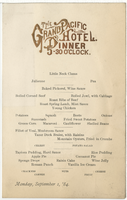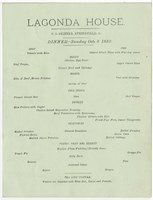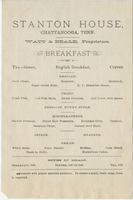Search the Special Collections and Archives Portal
Search Results

The Grand Pacific Hotel, dinner menu, Monday, September 1, 1884
Date
Archival Collection
Description
Text

Lagonda House dinner menu, Sunday, October 8, 1882
Date
Archival Collection
Description
Text

Stanton House breakfast menu
Date
Archival Collection
Description
Text

Christmas menu, 1884, Beebe House
Date
Archival Collection
Description
Text

Christmas dinner menu, 1883, Grand Hotel
Date
Archival Collection
Description
Text
Si Zentner Collection of Music Scores
Identifier
Abstract
The Si Zentner Collection of Music Scores consists of copyright agreements and original music scores from the career of musician Si Zentner. The manuscripts span from 1957 through 1996.
Archival Collection
Stonewall Park Collection
Identifier
Abstract
The Stonewall Park Collection (1983-1987) documents the Stonewall Park project, an unrealized gay community in Nevada. Material includes news clippings and ephemera, as well as financial records and ancillary documents detailing bankruptcies and litigation associated with the Stonewall Park project. Much of this material is photocopied from MS 1990-15 (Fred Schoonmaker Papers), held at the Museum of GLBT History in San Francisco, CA.
Archival Collection
Las Vegas-Clark County Library District Records
Identifier
Abstract
Collection is comprised of materials dating from approximately 1971 to 1996 about the Las Vegas Clark County Library District. Collection materials also include Charles Hunsberger's subject files from when he was library director of LVCCLD. The collection includes annual financial reports, clippings about the library district, photographs, master plan documents for Nevada libraries, and staff newsletters. In addition, the collection also includes materials documenting Hunsberger's efforts to secure a $22.2 million library bond in 1985.
Archival Collection
Albert S. Henderson Photograph Collection
Identifier
Abstract
The Albert S. Henderson Photograph Collection (1860s-1959) primarily contains black-and-white photographic prints of Albert S. Henderson and his family. Also included in the collection are photographic prints of Henderson during his tenure as a Nevada legislator and district judge. Other materials include postcards, negatives, and a tintype.
Archival Collection
George Kelly Ryan Photograph Collection
Identifier
Abstract
The George Kelly Ryan Photograph Collection (1929) depicts waterways in Southern Nevada and Northern Arizona. The collection consists of eight photographic prints and two photographic negatives depicting Saint Thomas, Black Canyon, Boulder Canyon, and the Colorado River.
Archival Collection
